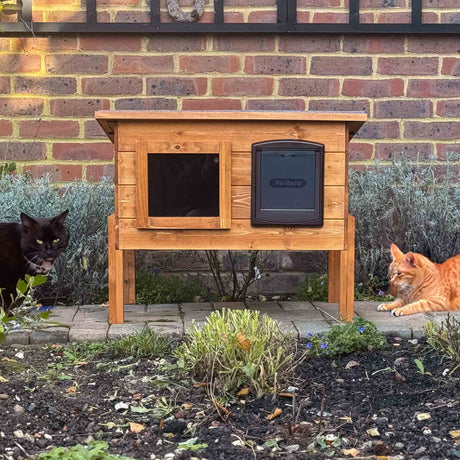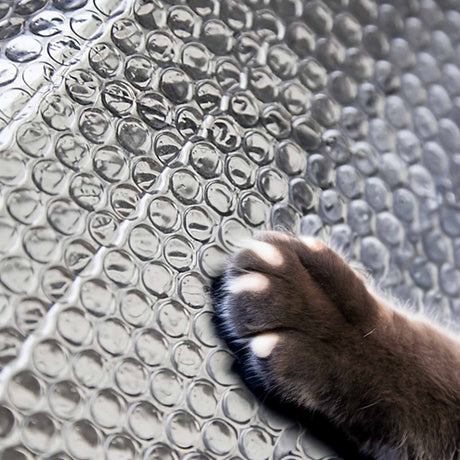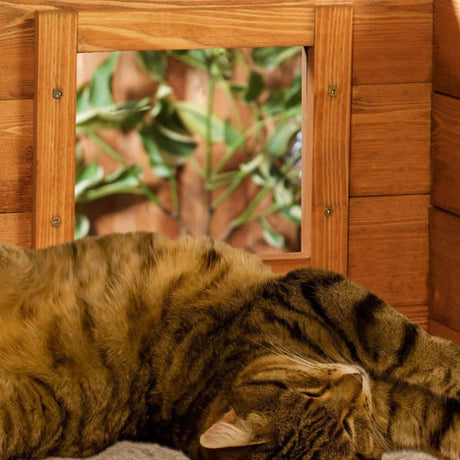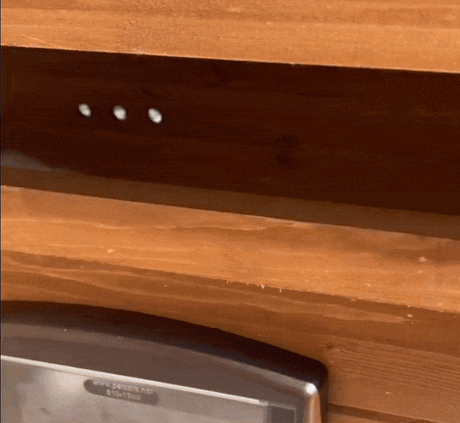A short while back, we had a friendly feline visitor that stopped in at the H&R headquarters every few days. It got us all thinking about this very thing, which is why we decided to look into it. And naturally, we wanted to share our findings with you.
Why a Stray Cat Might Come to Your House?

There are an estimated quarter of a million unowned cats living in urban areas across the UK. This means there is a very good chance you will have a close encounter with the feline kind if you haven't already.
If you find a stray cat hanging around your house, or trying to gain access inside, it is more than likely looking for a safe haven with food, water, and a little bit of TLC.
Identifying a Stray Cat
Before you do anything, it is crucial to establish whether the cat is, in fact, a stray. It could also be somebody's pet that has lost its way home or a feral cat. Knowing how to tell the difference will help you decide what plan of action to take.
1. Abandoned cats
An abandoned cat is usually tame and has gotten used to life on the streets. It was, at some time, somebody's pet, but after being abandoned or lost, it has been living on its own.
2. Feral cats
Unlike an abandoned cat, feral cats are not used to being around people. They tend to avoid contact and prefer to stay out of sight. If you can get close enough, you might notice one of its ears is clipped, which means it has been trapped, neutered and returned to the street.
3. Stray cats
A stray cat is usually in fairly good condition. It could be a neighbour's cat that has just popped in to say hello or a pet that has lost its way home.
Download this guide to help you identify whether it is a lost, abandoned or feral cat.
What to do When a Stray Cat Comes to your house
As mentioned before, a stray cat may come to your house because it needs shelter, food or water. To keep yourself, and your pets safe, there are a few things you should do when a stray arrives at your front door.
Give it food and water
If the cat looks friendly, approach it slowly and talk in a soft voice. Put down some cat food and a bowl of water. A feral cat will keep its distance, in which case you should too. You don't want to be bitten or scratched by a terrified cat. Keep in mind, feeding a stray will encourage it to come back for more, so be prepared to place food in a safe spot outside where the cat can access it.

Provide it with a warm, safe place
Let the cat in your house, especially if it is cold or raining. Give them a warm blanket or dry towel to lie on, and put it in a safe spot away from your other pets, and children. If the cat is wet and is tame enough for you to get close, use a towel to dry it. If the cat is scared or aggressive, avoid touching it until it settles in and feels calmer.
Check for identification
If the cat happily walks into your house, the first thing you should do is check if it is wearing a tag with its owner's contact details. If so, get in touch with them immediately. Heaven knows, they will be stressed out about their missing kitty. Remember to keep the cat away from your pets in the meantime. This is in case it has fleas, mange, worms or other diseases that can be passed onto your animals.
Place a paper collar around the cat's neck
While some stray cats tend to stick around for a few days at a time, others might come and go. It's worth putting a paper collar around the cat's neck to see if you can locate its owner.
All you need to do is:
- Print out the collar
- Put your contact number in the allocated space
- Place the collar around the cat's neck. Make sure there is at least two fingers space between the neck and the collar
- If after a few days you haven't heard anything, it is safe to assume the cat is a stray or lost
Take the cat to the vet
Even if the cat isn't wearing a collar, it could still be microchipped. Our suggestion is to take it to the vet or local rescue centre where they will be able to scan for a microchip. If it is, you will be able to get in touch with the owners and be a part of a happy family reunion. However, if there is no microchip, ask the vet to do a complete health check so you can keep the cat with you until the owner is found.
How to Locate the Cat's Owners
Create a flyer

Create a flyer yourself or use one of the free services. Make sure you use a clear photo of the cat as well as a detailed description. If there are any noticeable features, include them on the poster. Remember to also put your contact details on the flyer.
Take a few to your vet and local shelters, and let the staff know the cat is in your care. Place the flyers in the area where the cat was found, as well as in places where there is a lot of traffic. High streets, schools, gyms, post offices and stores are also good spots to post flyers.
Use social media and websites
Another good idea is to post the cat's details on Facebook. Find your local area's page, and also check if there are pet-focused community groups. Post the same information on your personal page and ask friends to share it.
There are also loads of websites, including Catlost and Animal Search that help reunite lost pets with their owners. For app users, PawBoost is a great tool to locate missing animals.
What To Do When You Can't Find the Owner
If you can't find the owner, there are a couple of options available.
Adopt the cat
If you've bonded with the cat and can't bear the thought of it not being around, you can adopt it. You will need to take it to the vet to get its shots and have it neutered or spayed. Keep in mind; however, adopting a cat is a huge responsibility. Not only will you need to spend time with it, but you will also have to spend money on food, toys and medical care.

Ask friends or family
If adopting the cat yourself isn't an option, check with friends and family members. Perhaps they can provide it with a loving home.
Speak to your local shelter
If long-term adoption is out of the question for you, but you can foster it until a home is found, speak to your local rescue centre or shelter. They will help find a forever home while the cat stays with you. If you are worried about the cat being euthanised, you can ask the shelter to put a limited hold on the cat. This means that if the cat isn't claimed by the owner after some time, you have the option to adopt it.
Private rescue groups can also help
Private rescue groups have no time limit on how long cats can stay with them, but they depend on foster homes and may only be able to take the cat if they have an open spot.
What to Do When a Feral Cat Comes to Your House
Feral cats, unlike strays, can't be rehomed, but you can help in other ways. Many organisations have a Trap-Neuter-Release (TNR) programme in place. As the name suggests, feral cats are trapped, neutered and then returned to a colony. To help identify cats that have been through this programme, the tip of one ear is clipped.

Place some food and water outside
Keep in mind feral cats are not used to people, and will avoid any contact with you. Rather than forcing it into your home, place some cat food and water outside in a safe place. You can also put a makeshift shelter outside so that the cat has somewhere to go when it is raining. To keep larger animals out, make sure that the space is small enough for the cat to gain access.
Trap-Neuter-Return
A lot of rescue organisations can assist with TNR, or, if you are comfortable with animals, you can try to do it yourself. Just remember that handling a feral cat requires a lot more skill and patience on your part. We've included 7 easy to follow steps that will help the operation run smoothly. Or if you prefer, scroll on down to watch the video tutorial.
1. Learn as much as you can about TNR
You must know as much as possible about TNR. There are plenty of guides online, as well as video tutorials. If you prefer, you can do a course to safely trap, neuter and release feral cats back into the community.
2. Speak to neighbours and the community
More often than not, families in your neighbourhood will have also 'adopted' the colony of feral cats, feeding them and making sure they are healthy. It is essential that you discuss the TNR programme with them, and make them aware of the benefits. In some instances, you may need to ask neighbours for access into their properties. Depending on how big the colony is, you might need to recruit people to help with feeding and trapping the cats.
3. Set up shelters and feeding stations
The first step is to set up feeding stations and shelters. It is also essential to establish a feeding schedule. By putting food out every day in the same place and at the same time, cats will very quickly learn to arrive on time for their meal, They'll also arrive on time when you are ready to trap them.
4. Find a safe spot to hold the cats
The entire TNR process will take about a week. This includes two to three days for trapping the cats, a day for the neutering or spaying and up to the three days for post-surgery recovery. It is a good idea to find somewhere to hold the cats during this time. Ideally, it should be warm, secure and sheltered. Sheds, barns, basements, spare rooms or empty offices are good options.
5. Make all the necessary arrangements
It's important to arrange everything before trapping the feral cat or cats. Some organisations offer a free service when neutering or spaying feral cats. And they also loan out humane traps weekly. Don't forget to arrange transportation to and from the clinic, and to collect and drop off the traps.
6. Trapping time
Make sure all food is withheld the day before you plan on trapping the cats. Remember to coordinate this with everyone involved, so no one accidentally leaves food out. Plan on leaving the traps out for a day or two if you are trapping one cat, and three to four days if you are trapping more. Some cats may be harder to trap than others, but after some trial and error, and a lot of patience, you will have managed to capture all of them.
7. Looking after the cats post-TNR
Once you have returned the cats back into the community, your job will be to feed them and provide them with shelter during the colder months. You must keep an eye out for any new arrivals that might need to be neutered or spayed.
Set aside a few minutes to watch this tutorial on how to trap, neuter and release feral cats back into the community.
Although it seems like a lot of work taking on a stray cat, or getting involved in a community project to trap them, have them neutered and released, trust us, it is well worth the effort. Not only will you be providing a cat with a loving home, but you will also be helping the ever-increasing problem of the overpopulation of feral cats.
Have you had any experience with any stray or feral cats? We always love to hear first-hand accounts from our readers. Please feel free to leave a comment below.









14 comments
I have 2 feral cats that iv been looking after since they were little in would watch them hunting mice n tryen ketch frogs infront my house and I would leave them treats and build them shelters but they never would really bother with the shelters and I couldnt understand why our mobile home is in the country and theirs packs of coyotees all over the place u can hear them celebrate there hunts almost every night so I started worrying about these 2 damm cats n that they’d survive through the night I know I could tame one to live with me but the brother in unoridicyltable I tried to give him shelter once before n when I closed the door omfg he went bezerk I thought he was gunna kill himself he panicked n kept tryen to jump through my windows I opened the door instantly but he just kept going head first into the windows it was terrifying then finally I chased him out before he got hurt poor thing I never seen anything like it in my life his brother chill as can be hes stay no issues he takes off for days at a time out edvantering m hunting I call him hunter but the brother seemed to rely on him for providing like he dont have the instinct to survive without him and he disapeered for few days too and he showed back up but his neck and belly areas are almost bald I thought he got attacked but I dont see blood really n almost like he was trapped or possibly a bacterial issue from im assuming getting into trash to eat without his brother to bring the food he ketches but iv tried to help cutt the knots of furr hanging from him but he goes into defense mode and will try to attack I’d say he will hiss at me if he feels cornered today both were here n it’s down pouring I let them in for a lil bit but they wont let me close the door n I just leave the door wide open so I fed them nnsent them on there way I built a tent barn yesterday for safe shelter for them with a cat house inside but no way they wont bother with it I noticed they are hiding out under my house in the storage areas witch be hard for bigger prey to get them but would be awfully dark in there but today the unpredictable cat did sumthing very strange he rand and jumped head first from outside into my front doors window idk if he is going visouse n possibly rabies or unsafe to keep letting around as I have 3 kids or if he wanted in due to the heavy rain for shelter or just wanted food he was tryen to get bag of garbage by my door when he was inside so I’m sitting just trying to understand this whole experience and if anyone can direct me or give me advice on the situation like iv basically helped these cats since they were babies and they grew on me but ones health is very questionable with all the hair loss n he wont take to me or allow me to groom him it’s been bothering me alot I lost my 2 brother recently right around the time these cats appeared in my life and they kinda been helping me through the grieving process n they grew on me I’m worried that they’ll get hurt every night it’s hard on my anxiety an my girlfriend sumtimes gets mad cuz I keep checking for them through the night see if there ok
A neighbor knocked on my door about a cat she saw in the hallway where I live, thinking that this cat was mine and I said no, my cat lives with me in my place, and upon reading all the comments I will give this cat, but I don’t know what sex it is or how old it is, but it’s very cold and raining outside and I don’t want to put the cat outside, it would be very dangerous for it and I don’t want to call the ASPCA,because if no one adopts him, they will kill the cat, as I know what they will do, and because it is all black, no one would adopt him, as my cat who is 5 years old, no one wanted him either, and everyone in my building knows that he lives with me, as he is very friendly with everyone, and he is a domestic cat, unlike street cats, very different attitude, because outside cats are very aggressive, because they have to fend for themselves, could anyone reading this post, please advise me, I will appreciate your comments.
A cat comes to my kitchen window every day. He was scared of me at 1st.I talk to it. And feed and give it water.Sometimes he brings his 3 friends.The cat looks at me until I talk to it.
Stray cat keeps coming in my garden I feed him he stays around most of the day. I know who owns him they have have been round for him he runs away from then.
Comes back to mine for food he’s not been neutered what do I do
I don’t have in my place just stays in garden.
Please give me some advice
Thank you
I am sure this post has touched all the internet visitors,
its really really good paragraph on building up new web site.
I found a cat at my old home had the door open it ran right in it tried to take over the whole chouch and it tried to bite me to do so the people that had the cat left it and did not come back. Cat likes to be around me all the time like her new home
There’s definately a lot to learn about this subject. I love all of the points you’ve made.
I have one question-maybe you can help me-a feral/indoor and outdoor cat came to my home 4 years.. This cat will not leave my home-he is very friendly with us. He now comes in eats, sleeps inside my home. The only problem is I do not have a litter box inside and he likes to go out, but it is preventing me from going out since I let him out at all times of the day. I truly do not know what to do. Can you help if you have had any experiences such as my. He is neutered.
During the pandemic me and my neighbors noticed one of the stray cats had kittens. Me and 2 of my neighbors fed them. We did call the humane society and ask if they could get them and they said "Good luck but if you can catch them, we can take if you drop off. I watched the set of 5 prints over the years become only 1. If it’s nice out me and my dog are outside gardening or hanging out. I have to drag plants in and out till June pretty much bc I live in WI, but last May he came in, as my dog and I were sitting on the floor as I took a break for a minute with the door open. This guy came inside grabbed a milkbone, ran to the corner, ate it and left. The next day he came back in, and is never left since. Well he’s gotten out a few times but always comes back. 2 days he was rubbing against my legs while I was in the garden. I didn’t pay any attention cuz I thought it was my cat. I did not approach him for a long time I don’t know how long even but six months later he’s sleeping in the nnbed with my dog and my other cat and they all love each other. I had a few wild animals this year like a baby opossum, another stray cat, and a bunny that came regularly. I am so allergic to cats and now I have two. This cat is not good with anybody other than me for some reason, no he doesn’t like men, which makes sense because men are generally, idk, but maybe it’s because of the guy here. Anyways I didn’t go out looking for any of them, but I love my family and yes there’s a few days here and there that I don’t eat because I can’t afford to, but that’s okay. What kind of karma would it be if I got rid of any of them, esp the stray, being only one who I didn’t agree to take
This is actually the 2nd cat whom was Ferel, moved in and became amazing cats. I would prefer three dogs just because dogs are cooler and I’m severely allergic to the cats. My dog is a schnauzer so my allergies aren’t bothered by her.
Hi, in need of some advice really….. each night theirs been an adult cat coming into my home through my cat flap, which I have a 1 year old cat also an this other cat keeps attacking my cat. He clearly doesn’t like this cat as he is in his territory, I’m heavily pregnant so he’s become protective also. I don’t want to have to stop him going out as it’s not fair on him, but I don’t know what else to do.
I have had him neutered ect, so he didn’t get a chance to spray the garden before going outside, so he hasn’t had a chance to mark his territory either.
Any advice as, I feel so confused on what to do atm.
Thank you
this awesome! my house always better for cat, when I open the door stray cat stand for ask food there.
Hello to every body, it’s my first visit of this blog; this web site carries amazing and genuinely good material in support of visitors.
Cats are not just pets; they become cherished members of the family, offering companionship and comfort. Their independent and mysterious nature adds an element of intrigue, making every moment spent with them an adventure. Whether curled up in a sunbeam or chasing after a toy, cats have a magical way of brightening our lives.
Hi my name is Mike just have patients keep doing what u r doing I went through the same with my Mr g that’s the cats name he did the same thing now he jumps on my lap patients it will happen